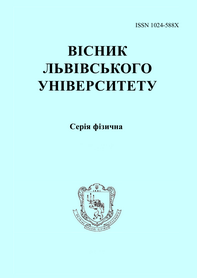DOI: https://doi.org/10.30970/vph.56.2019.11
New method of calculation of stellar equilibrium with axial rotation
M. Vavrukh, N. Tyshko, D. Dzikovskyi, O. Stelmakh

| Visnyk of the Lviv University. Series Physics
56 (2019) ñ. 11-30
DOI: https://doi.org/10.30970/vph.56.2019.11 New method of calculation of stellar equilibrium with axial rotationM. Vavrukh, N. Tyshko, D. Dzikovskyi, O. Stelmakh |  |
New method for the calculation of equilibrium of stars with axial rotation was proposed in the frame of polytropic model. Our approach is based on the simultaneous use of differential and integral forms of equilibrium equation. The system of the equations is exactly determined and allows to calculate correctly integration constants. General method is illustrated in the case of linear equations describing the equilibrium of polytropes with indexes n=0 and n=1. The solution of two-dimensional differential equations in partial derivatives were represented in analytical form. The dependence of surface shape, mass and volume of star on angular velocity were investigated in the case n=0, it was showed the presence of two modes -- ellipsoidal and disk and determined the critical value of velocity \Omegamax. For the polytrope with index n=1 the solution of the second order differential equation in partial derivatives can be represented in the form of expansion in series by spherical Bessel functions of first kind and Legendre polynomials of radial variable. Unlike works of E. Milne and S. Chandrasekhar, which are based on perturbation theory with respect to rotation, in our works integration constants are determined self-consistenly with accurate consideration of the ellipsoidal shape of the stellar surface. The solution of linear system of algebraic equations for the integration constants are determined simultaneously with the eccentricity and equatorial radius by iteration method. The dependences of the characteristics of star (polar and equatorial radii, eccentricity, mass, volume, moment of inertia) on the value of dimensionless angular velocity \Omega were calculated. At small values \Omega our results coincide with the results of E. Milne, S. Chandrasekhar and R. James and are significantly different from them at small velocities, which are closed to the critical \Omegamax. The last one is approximately on 20\% less than calculated by R. James. The results of numerical calculation were represented in the form of tables and figures.